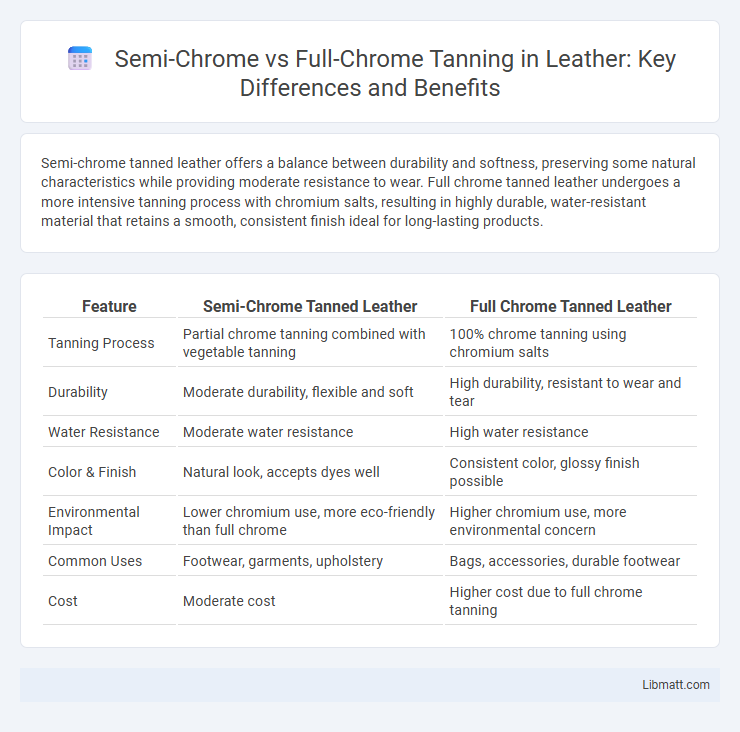Semi-chrome tanned leather offers a balance between durability and softness, preserving some natural characteristics while providing moderate resistance to wear. Full chrome tanned leather undergoes a more intensive tanning process with chromium salts, resulting in highly durable, water-resistant material that retains a smooth, consistent finish ideal for long-lasting products.
Table of Comparison
| Feature | Semi-Chrome Tanned Leather | Full Chrome Tanned Leather |
|---|---|---|
| Tanning Process | Partial chrome tanning combined with vegetable tanning | 100% chrome tanning using chromium salts |
| Durability | Moderate durability, flexible and soft | High durability, resistant to wear and tear |
| Water Resistance | Moderate water resistance | High water resistance |
| Color & Finish | Natural look, accepts dyes well | Consistent color, glossy finish possible |
| Environmental Impact | Lower chromium use, more eco-friendly than full chrome | Higher chromium use, more environmental concern |
| Common Uses | Footwear, garments, upholstery | Bags, accessories, durable footwear |
| Cost | Moderate cost | Higher cost due to full chrome tanning |
Introduction to Leather Tanning Methods
Semi-chrome tanned leather combines chrome tanning with vegetable tanning, balancing durability and natural aesthetics, whereas full chrome tanned leather undergoes comprehensive chrome tanning, resulting in enhanced softness and water resistance. Chrome tanning uses chromium salts to accelerate processing and produce lightweight, supple leather suited for mass production. Semi-chrome tanning partially uses chromium salts but finishes with vegetable extracts, offering a more eco-friendly alternative with distinct textures and improved structural integrity.
What is Semi-Chrome Tanning?
Semi-chrome tanning involves partially transforming raw hides through a controlled combination of chrome tanning and vegetable tanning methods, resulting in leather that balances durability with natural texture. This process enhances leather flexibility and resistance while preserving some of the organic feel characteristic of vegetable-tanned leather. Semi-chrome tanned leather is often favored for products requiring both a soft touch and improved robustness against wear and moisture.
What is Full Chrome Tanning?
Full chrome tanning is a leather tanning process that uses chromium salts, primarily chromium sulfate, to transform raw hides into durable, flexible leather within a few days. This method offers superior water resistance, heat stability, and softness compared to traditional vegetable tanning, making it ideal for producing high-quality garments, footwear, and upholstery. Understanding full chrome tanning helps you choose leather products with enhanced durability and consistent texture.
Key Differences Between Semi-Chrome and Full Chrome Tanned Leather
Semi-chrome tanned leather combines chrome tanning with vegetable tanning, offering a balance of softness, durability, and environmental impact, while full chrome tanned leather uses only chromium salts, resulting in a highly flexible and water-resistant material. The key difference lies in the tanning process: full chrome tanning accelerates production and enhances color retention but may have a heavier environmental footprint, whereas semi-chrome tanning reduces chromium use, balancing eco-friendliness with quality. Your choice depends on the desired final properties and sustainability priorities of the leather product.
Durability and Performance Comparison
Semi-chrome tanned leather offers moderate durability with a balance of flexibility and resistance, making it suitable for products requiring both softness and strength. Full chrome tanned leather provides superior durability and enhanced water resistance, delivering excellent performance in heavy-use applications due to its robust tanning process. Your choice depends on the required toughness and longevity, with full chrome excelling in rugged conditions while semi-chrome suits everyday wear with comfortable texture.
Environmental Impact of Tanning Processes
Semi-chrome tanning reduces environmental impact by using fewer chemical agents and shorter processing times, resulting in lower water and energy consumption compared to full chrome tanning. Full chrome tanning involves extensive use of chromium salts, leading to higher risks of toxic effluent contamination and chromium waste disposal challenges. Sustainable leather production increasingly favors semi-chrome processes due to their improved eco-efficiency and reduced chromium pollution.
Applications and Typical Uses
Semi-chrome tanned leather offers a balanced combination of natural aesthetics and durability, making it ideal for high-quality upholstery, footwear, and fashion accessories where moderate water resistance and softness are required. Full chrome tanned leather is highly durable, more water-resistant, and flexible, commonly used in automotive interiors, heavy-duty footwear, and industrial goods demanding enhanced strength and longevity. Choosing between semi-chrome and full chrome tanning depends on the end-product's need for stiffness, water resistance, and surface finish quality.
Cost and Affordability Analysis
Semi-chrome tanned leather offers a cost-effective alternative to full chrome tanning, resulting in lower production expenses and more affordable retail prices. The reduced chemical usage and shorter processing time in semi-chrome tanning contribute to significant savings without substantially compromising leather quality. Consumers seeking budget-friendly leather goods often find semi-chrome options to be a practical balance between durability and cost.
Care and Maintenance Requirements
Semi-chrome tanned leather requires gentler care with mild cleaners and regular moisturizing to preserve its natural texture and prevent drying. Full chrome tanned leather is more durable and resistant to water and stains, making it easier to clean with standard leather conditioners and less frequent maintenance. Understanding the differences in care helps you extend the lifespan and appearance of your leather goods effectively.
Which Tanning Method is Best for Your Needs?
Semi-chrome tanned leather offers a balance between durability and flexibility, making it ideal for products requiring moderate wear and soft texture. Full chrome tanning provides superior water resistance and strength, perfect for heavy-use items like footwear and upholstery. Your choice depends on whether you prioritize softness or durability in your leather goods.
Semi-chrome vs full chrome tanned Infographic

 libmatt.com
libmatt.com